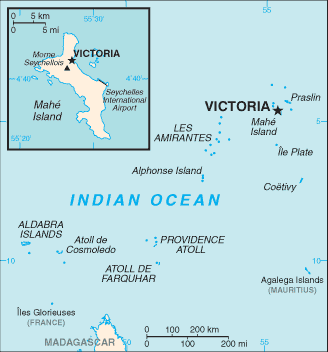In a follow-up on the suspected plague situation on Seychelles, the World Health Organization (WHO) published the following news release that includes a timeline, public health response anda risk assessment:
On 10 October 2017, the Seychellois Ministry of Health notified WHO of a probable case of pneumonic plague. The probable case had visited Madagascar and returned to Seychelles on 6 October 2017. He developed acute respiratory symptoms on 9 October 2017 and presented to a local health centre. Based on a medical examination and reported history of recent travel to Madagascar, pneumonic plague infection was suspected and he was immediately referred to hospital where he was isolated and treated.

On 11 October 2017, a rapid diagnostic test was performed in country on a sputum sample and was weakly positive. From 9 through 11 October 2017, eight of his contacts developed mild symptoms and were isolated. Two other suspected cases, with no travel history to Madagascar and no established epidemiological link to the probable case, were also identified, isolated and placed on treatment.
Ten samples from suspected cases, including the probable case, were collected and sent to the Institut Pasteur Paris and all tested negative on 17 October 2017.
13 October was the last day of monitoring of over 320 contact persons of the probable case, including 41 passengers and seven crew members from the flight, 12 close family members, and 18 staff and patients from the health centre visited by the probable case. All were provided a prophylactic course of antibiotics to prevent the disease.
Overall, a total of 1223 contacts had been registered and were followed up. Of these, 833 contacts were given prophylactic antibiotics. Four suspected cases were identified from among the contacts and were put on treatment.
Following the negative test results from Institut Pasteur Paris, all contacts who were isolated in the hospital, including the probable case, have been discharged. Antibiotic prophylaxis to the identified contacts, including monitoring of their health for symptom development has been discontinued.
A Crisis Emergency Committee was established on 10 October 2017, to coordinate surveillance, contact tracing, case management, isolation and supplies.
The government has allocated funds to support the Committee interventions, enabling the setting up of a temporary isolation ward (whilst the existing ward is expanded), procurement of key supplies, contact tracing, and expansion of contact tracers’ training.
Spain is on Sale! Save up to 25% on select tours
Air Seychelles flights to and from Madagascar had been stopped on 8 October 2017 to reduce likelihood of further importation of plague cases from Madagascar. WHO does not recommend restrictions on travel and trade. Since 10 October 2017, the Madagascar Ministry of Health, with support from WHO, has implemented exit screening at the international airport in Antananarivo to prevent international spread. Further support from WHO and partners is being planned to strengthen measures at points of entry to avoid international spread.
WHO is advising the Government of Seychelles on the implementation of public health measures that are in line with the WHO International Health Regulations, such as enhanced surveillance, isolation and treatment of suspect cases, contact tracing and prophylactic treatment of potential contacts.
Plague has never been reported in Seychelles, and at this stage, no plague cases have been confirmed in Seychelles. None of the previously reported probable or suspected cases have died.
The risk of pneumonic plague in the Seychelles is considered as low and the overall regional and global risk levels as very low.
Related:
- Monkeypox update: 9 confirmed cases reported in Nigeria
- Marburg outbreak: Uganda Health Ministry puts case tally at 9
- New cases of pneumonic plague has continued to decline in all active areas across Madagascar

